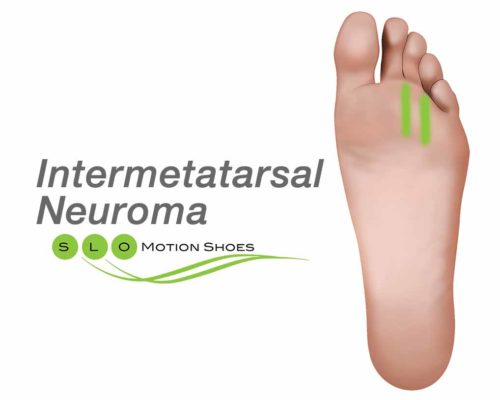Neuroma describes the thickening, or enlargement, of tissue surrounding a nerve, which compresses the nerve. Intermetatarsal refers to an area on the ball of your foot between two of the toes, most commonly the third and fourth toes. Intermetatarsal neuroma, also known as Morton’s neuroma is the most common neuroma of the foot.

Symptoms
Sensation that something is inside the ball of the foot
Feeling as if there is something inside the shoe (like a pebble)
Sharp, burning pain in the ball of the foot and toes
Numbness and tingling sensation in ball of foot extending to toes
Symptoms begin intermittently and worsen over time
Causes
Anything that causes compression, irritation, or injury to the nerve
Shoes with tapered toe or high-heeled shoes
Foot deformities, such as bunions, hammertoes, high arches or flatfeet
High-impact activities that subject ball of foot to repetitive trauma, such as running
Sports that require tight shoes, such as snow skiing and rock climbing
Treatments
Treatment is aimed at relieving pain and allowing the nerve to heal. Consult with your doctor early in the development of symptoms. Morton’s neuroma can lead to permanent nerve damage. Surgical treatment may be indicated if conservative measures are ineffective.
Over the counter pain medication, such as ibuprofen (Advil, Motrin) or naproxen (Aleve), as needed
Avoid high-impact activities until condition improves
Ice on affected area
Using padding to support arch and decrease compression on the nerve
Wear shoes with roomy toe area and extra depth
Avoid high heels
Custom orthotic device
Injection therapy with cortisone, dilute alcohol, or local anesthetic
A neuroma is a localized degenerative process within a nerve caused by repetitive low-grade nerve trauma. The repetitive trauma causes swelling within the nerve and the development of subsequent scar tissue. The most common neuroma occurs between the metatarsal bones of the foot and is termed intermetatarsal neuroma. The nerves that supply skin sensation between the second through the fourth toes are most commonly involved.
Increased motion and friction between the metatarsal bones causing impingement, direct pressure on the nerve during walking as well as the independent up and down motion of the metatarsals causing shear can all be attributed to the development of this condition.
The type of symptoms encountered can be varied and may include; sharp, shooting, stabbing or burning pain, numbness, tingling or cramping sensations located on the ball of the feet extending into the toes. The most common area involved is between the third and fourth metatarsals and less commonly between the second and third metatarsals.
Shoe and orthotic therapy as well as the cautious use of anti-inflammatory medications including cortisone are traditionally recommended treatment. Other conservative treatments including the use of dilute alcohol injections have been shown to be helpful in decreasing the pain associated with the intermetatarsal neuroma.
Conservative therapies are successful a majority of the time in relieving pain and allowing the return to all normal daily activities. If pain is ongoing despite these conservative therapies surgical treatment may be indicated.
Intermetatarsal Neuroma: Causes, Diagnosis, and Treatment
Neuroma Condition Specific Orthotic
Intermetatarsal Neuroma (Morton’s Neuroma) Discussion Board
Select a View
Click on the view that most represents the area of discomfort that you are experiencing. Drag your cursor over your area of concern to obtain a brief description of the potential condition.
Suggested Product
-

Neuroma Orthotic
$75.00Reduce pressure and friction on the nerve in the ball of the foot.Select options







